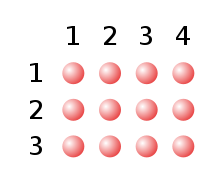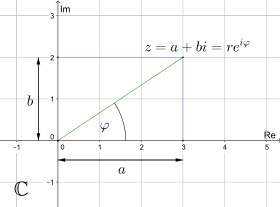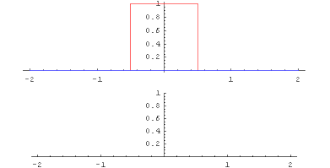Product (mathematics)
A product is the result of a multiplication and also a term that represents a multiplication. The linked elements are called factors.
In this sense, a product is a representation of the form
where one 


Derived from the Latin word producere meaning to produce, "product" originally denoted the result of multiplying two numbers (from Latin: multiplicare = to multiply). The use of the multiplication dot 

Products of two numbers
Here, is always true. 
product of two natural numbers
For example, if you arrange tiles in a rectangular pattern in r rows of s tiles each, you will need
Pieces. The multiplication here is a shorthand notation for the multiple addition of r summands (corresponding to the r rows), all of which carry the value s (there are s tiles in each row). But you can also calculate the total number by adding the number s (corresponding to the number of stones standing one behind the other in a column) r times in total (corresponding to the number r of such columns of stones standing side by side) (you need r-1 plus signs for this). This already shows the commutativity of the multiplication of two natural numbers.
If one counts the number 0 to the natural numbers, then these form a half ring. The inverse elements of the addition are missing for a ring: There is no natural number x with the property 3+x=0.
A product in which the number 0 appears as a factor always has the value zero: an arrangement of zero rows of tiles does not include a single tile, regardless of the number of tiles per row.
product of two integers
Adding the negative integers gives the ring 
In words, this table says:
- Minus times minus equals plus
- Minus times plus equals minus
- Plus times minus equals minus
- Plus times plus equals plus
For a strictly formal definition about equivalence classes of pairs of natural numbers compare the article about integers.
product of two fractions
In the integers you can add, subtract and multiply without restriction. Division by a non-zero number is possible only if the dividend is a multiple of the divisor. This restriction can be removed by moving to the body of rational numbers, that is, to the set 
If necessary, the result can still be shortened.
product of two real numbers
As Euclid was already able to prove, there is no rational number whose square equals two. Likewise, the ratio of the circumference to the diameter of a circle, i.e. the circle number π, cannot be represented as a quotient of two integers. Both "gaps" are filled by a so-called completion in the transition to the body of real numbers 
Any real number can be thought of as an infinite decimal fraction. For example, 

product of two complex numbers
Even over the set of real numbers there are unsolvable equations such as 



Geometric interpretation
A complex number can also be written in plane polar coordinates:
Is furthermore
then, due to the addition theorems for sine and cosine, the following applies
Geometrically this means: multiplication of the lengths with simultaneous addition of the angles.
product of two quaternions
Even the complex numbers can be extended algebraically. A real four-dimensional space, the so-called Hamiltonian quaternions 



3 times 4 equals 12

A complex number in polar coordinates
More examples of commutative rings
Remainder classes of integers
That the product of two numbers is odd exactly when both factors are odd is a widely known fact. Similar rules apply to divisibility by an integer N greater than two. Here, the even numbers correspond to the multiples of N; an even number is divisible by two without remainder. For the odd numbers, one should distinguish which remainder is left when this number is divided by N in whole numbers. Modulo 3 - according to the way of speaking - there are three remainder classes of integers: Those that are multiples of three, those with remainder 1, and those with remainder 2. The product of two such numbers always has remainder one modulo three.
The set of these residue classes, 

an addition and by
explains a multiplication. The resulting ring is called the residue class ring modulo N. Precisely when N is a prime number, it is even a body. Example: modulo 5 the remainder class of 2 is inverse to that of 3, since 6 modulo 5 is one. The systematic finding of multiplicative inverses modulo N is done by means of the Euclidean algorithm.
Function rings
If the ring R is commutative, then the set forms 

for all 
If one chooses as the ring R the real numbers 




Convolution product
→ Main article: Convolution (mathematics)
Let 
Then the improper integral is
for each real number t is also finite. The function f*g defined in this way is called the convolution product or convolution of f and g. Thereby f*g is again integrable with finite improper magnitude integral. Furthermore, f*g=g*f, i.e., the convolution is commutative.
After Fourier transform, the convolution product is the point-wise defined product except for a constant normalization factor (so-called convolution theorem). The convolution product plays an important role in mathematical signal processing.
The Gaussian bell curve can be characterized by the fact that its convolution with itself again results in a bell curve that is somewhat stretched in width (cf. here). It is precisely this property that underlies the central limit theorem.
Polynomial Rings
The set ![\R[X]](https://www.alegsaonline.com/image/16d740527b0b7f949b4bf9c9ce004134bb490b68.svg)
with
These rings play a major role in many areas of algebra. For example, the body of complex numbers can be elegantly defined formally as a factor ring ![\R[X]/(X^2+1)](https://www.alegsaonline.com/image/4a9561fb97d235fa5d9d975ea50b9ac958058410.svg)
In the transition from finite sums to absolutely convergent series or formal power series, the product discussed here becomes the so-called Cauchy product.

Convolution of the rectangular function with itself yields the triangular function
Search within the encyclopedia


















